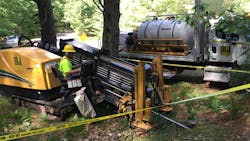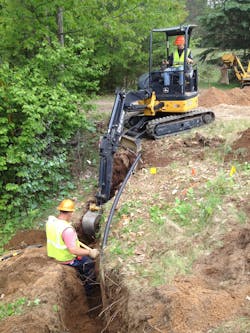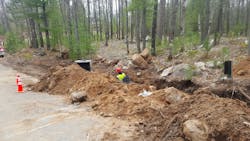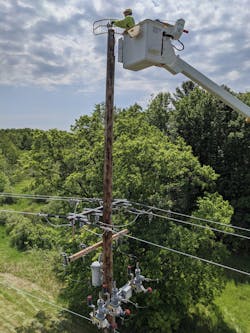Remote-Area Reliability at a Reasonable Cost
The system modernization and reliability project (SMRP) is intended to build on WEC Energy Group’s reliability in these remote areas at a reasonable cost. By replacing aging overhead lines with underground circuits, the US$425 million project has resulted in a remarkable 97% reduction in electric outage minutes in the targeted areas to date.
Need for Improvement
WEC Energy Group’s utility subsidiary, Wisconsin Public Service (WPS), is leading SMRP. WPS serves about 453,000 electric customers in 18 Wisconsin counties over an area of 11,000 sq miles (28,490 sq km). Around 71% of its service area is medium- to high-density forest, which increases the likelihood of outages for customers served by overhead power lines. In addition to the challenge of maintaining adequate vegetation clearances, invasive insects like the emerald ash borer can lead to tree debris stacking up in rights-of-way.
When setting out to implement SMRP, project leaders compared outage data to industry reliability benchmarks as well as with other Wisconsin investor-owned utilities, and the need for better electric reliability was evident. Almost half of the customers surveyed indicated they valued and were willing to pay for improvements through increased electric rates. At the same time, advancements in underground cable installation and testing techniques as well as improvements in underground cable and equipment were coming down in price and increasing the reliability of underground electric distribution.
Changes Implemented
SMRP has accelerated WPS’s effort to replace aging overhead lines with underground circuits while modernizing the utility’s electric distribution system and improving reliability. As part of this reliability and modernization effort, the utility added self-healing technology, including automating mainline circuits to provide fault location, isolation and service restoration (FLISR) capabilities.
The initial phase of the project began in 2014. WPS’s goal was to install nearly 1000 miles (1609 km) of underground circuits and deploy distribution automation (DA) equipment on nearly 400 miles (644 km) of existing three-phase mainline electric distribution lines. The utility also worked with customers to convert their overhead electrical services to underground and replace pole-mounted equipment, such as transformers and fuses, with padmounted equipment.
The DA equipment includes radio-controlled switching devices strategically located at integral points on the distribution grid. These devices automatically reroute electricity around faulted sections of line within minutes of an outage to restore power to customers. So far, a total of 386 miles (621 km) of three-phase main lines have been equipped with DA equipment. Since the implementation of DA in August 2014, 82 outage events have occurred on main lines under DA control, and a total of 37.37 system average interruption duration index (SAIDI) minutes have been saved.
After several years of successful construction and proven reliability benefits, WPS applied for and received approval to expand SMRP. In this second phase of the project, running from 2018 through 2021, WPS is installing an additional 960 miles (1545 km) of underground circuits to replace overhead lines. At a cost of US$207 million, this phase will provide an additional 17% improvement in electric reliability.
Extensive Coordination
SMRP required extensive coordination with the U.S. Army Corps of Engineers, State Historic Preservation Office, Wisconsin Department of Natural Resources, U.S. Fish and Wildlife Service, and U.S. Forest Service throughout the environmental permitting process, which began over two years in advance of construction. To date, installations have involved implementing avoidance and minimization measures for about 5750 wetlands, 172 archaeological (non-burial) sites and 81 burial sites. WPS employs environmental inspectors during construction to conduct preconstruction meetings with the installation crews, monitor avoidance areas, inspect erosion and sediment control measures, and monitor revegetation success.
With less than a year to go, WPS has replaced 1294 miles (2083 km) of overhead lines with 1629 miles (2622 km) of underground circuits. Hundreds of employees have spent over 1.5 million hours of labor installing 19.3 million ft (5.9 million m) of underground cable, 1787 padmount enclosures and switchgear devices, 5103 new underground electric services, 4341 junction enclosures and 13,008 padmount transformers.
As part of this vast deployment, WPS deployed new cable constructions and materials to minimize moisture ingress and improve ergonomics for installation. The utility also used advanced partial-discharge testing techniques to verify the quality of materials and workmanship. Throughout it all, WPS managed contact with landowners of 50,943 parcels of property and obtained 9810 easements.
SAIDI Improvements
“The project has been a game-changer for WEC Energy Group,” said Paul Gogan, director, electric distribution asset management for WEC Energy Group. “SMRP has exceeded expectations, improved reliability and increased customer satisfaction. So far, the project has resulted in greater than a 97% reduction in electric outage minutes in those areas where overhead lines have been replaced with underground circuits.”
The total average annual SAIDI impact for all underground segments installed to date through SMRP is 127 minutes, based on historical SAIDI averages. For reference, this compares to a long-term average annual SAIDI of 336 minutes, based on historical averages prior to SMRP, for the entire customer base.
These improvements in reliability indices are provided in SAIDI minutes saved and calculated by subtracting the actual SAIDI minutes post-SMRP from the historical minutes reported. For example, WPS’s four-year average SAIDI impact for the 2014 underground segments was 22.84 minutes with 125 outage events per year, before the SMRP work. During 2018, there were eight outage events in the 2014 segment areas, with a total SAIDI impact of 0.46 minutes. Therefore, the annual SAIDI improvement to the segments replaced with underground facilities in the 2014 project year is 22.37 minutes.
Safety Record
WPS is proud of its safety record on the project. “Of all of SMRP’s accomplishments, one of our most significant accomplishments has to be our safety record,” said Steve Schott, operations manager at WPS. “Our project team has been able to perform their work safely and efficiently, and return home to their families at the end of the day. There’s nothing more important than that.”
Throughout seven years of construction and 1.5 million hours of labor to implement SMRP, there have been 12 minor injuries to employees and 11 recordable Occupational Safety and Health Administration incidents. There were only two incidents of lost time, resulting in four days of lost time or restricted duty. The SMRP total recordable incident rate is currently 1.4, compared to a national average of 2.6 for this type of construction.
Moving Forward
WPS will replace an additional 223 miles (359 km) of overhead lines with underground circuits during the 2021 construction season, the final year of SMRP. After this effort is complete, the utility will continue to focus on reliability improvement on a smaller scale through undergrounding in target areas as well as rebuilding overhead lines and upgrading equipment. The operating, inspection and maintenance costs associated with vegetation line clearance, overhead distribution pole assets and outage response have been reduced, and savings will continue to be realized in the coming years.
This project is part of WEC Energy Group’s commitment to deliver world-class reliability to its customers across America’s heartland. SMRP built on existing industry knowledge from other utilities, advanced construction techniques and close coordination between the project team and customers to schedule the service conversions. The project will serve as a model for WEC Energy Group in evaluating future areas and projects for system improvement and asset renewal.
Paul Gogan serves as director — electric distribution asset management for WEC Energy Group. In this role, Gogan is responsible for the design, maintenance, operation and construction of electric distribution and transmission facilities. He has been with the company since 1989. Gogan earned a BS in electrical engineering in 1986 and a MBA in 2000 with a Beta Gamma Sigma honor, both from Marquette University. He is a registered professional engineer in Wisconsin and Illinois. Gogan is the chairperson of the Edison Electric Institute Electric Distribution Executive Committee, chairperson of Marquette University’s Electrical Engineering Industry Advisory Board, member of the Electric Power Research Institute Power Delivery and Utilization Sector Council, senior member of the Institute of Electrical and Electronics Engineers, and adviser to University of Wisconsin-Milwaukee’s Grid Connected Advanced Power Electronics and Connected System Institute. He is also a board member of the Midwest Energy Resource Consortium. In 2020, Gogan was presented the Outstanding Contributor to Reliability Award from PA Consulting.
Alison Trouy is a senior communications specialist at WEC Energy Group. She recently earned a master’s degree in corporate communication from Marquette University. She has a bachelor’s degree in broadcast journalism from the University of Illinois Urbana-Champaign.
About the Author
Alison Trouy
Alison Trouy is a senior communications specialist at WEC Energy Group. She recently earned a master’s degree in corporate communication from Marquette University. She has a bachelor’s degree in broadcast journalism from the University of Illinois Urbana-Champaign.
Paul Gogan
Paul Gogan serves as director — electric distribution asset management for WEC Energy Group. In this role, Gogan is responsible for the design, maintenance, operation and construction of electric distribution and transmission facilities. He has been with the company since 1989. Gogan earned a BS in electrical engineering in 1986 and a MBA in 2000 with a Beta Gamma Sigma honor, both from Marquette University. He is a registered professional engineer in Wisconsin and Illinois. Gogan is the chairperson of the Edison Electric Institute Electric Distribution Executive Committee, chairperson of Marquette University’s Electrical Engineering Industry Advisory Board, member of the Electric Power Research Institute Power Delivery and Utilization Sector Council, senior member of the Institute of Electrical and Electronics Engineers, and adviser to University of Wisconsin-Milwaukee’s Grid Connected Advanced Power Electronics and Connected System Institute. He is also a board member of the Midwest Energy Resource Consortium. In 2020, Gogan was presented the Outstanding Contributor to Reliability Award from PA Consulting.




